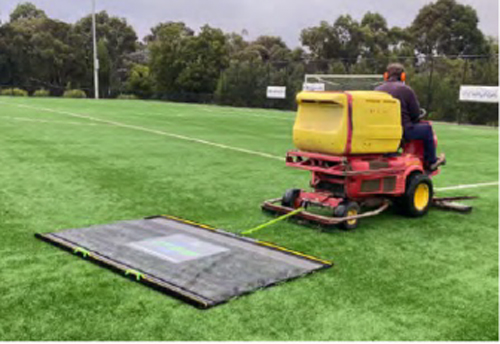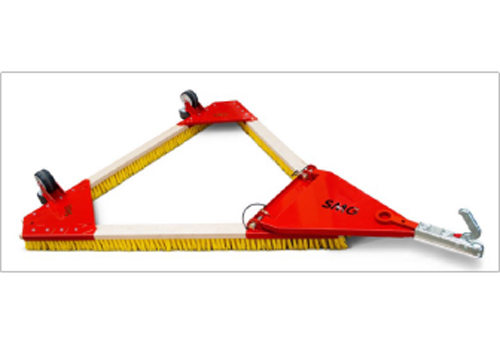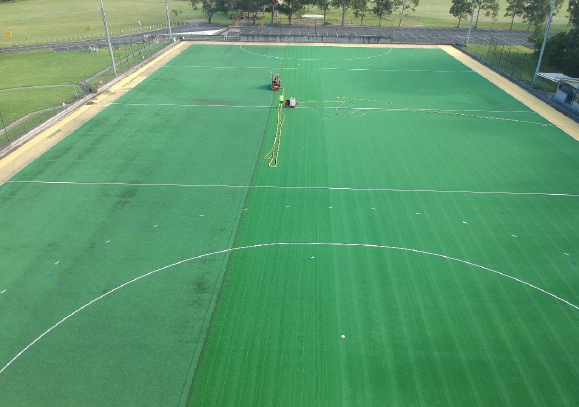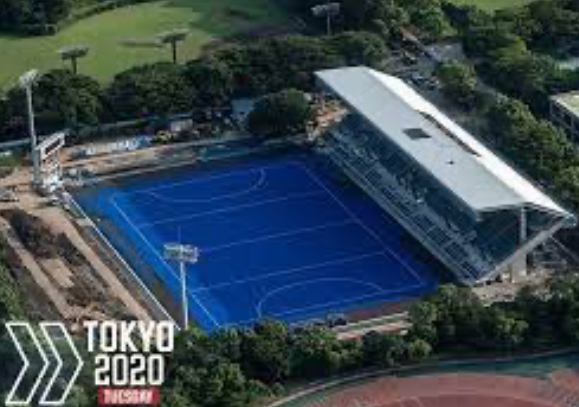At Sports Clean, we’re always interested in the evolution of sports surfaces and how best to care for those surfaces. When it comes to synthetic hockey field maintenance, the Synthetic Grass industry has certainly come a long way.
In this post, we’ll share some helpful tips on caring for your synthetic hockey field, but first, let’s take a look at how things have evolved over recent years …
From Knitted Nylon to Sugar Cane
As the enjoyment of watching the 2020 Tokyo Olympic Games from afar starts to fade and Australia’s overall Medal performance celebrated and analysed, the 2020 Games also provide a good opportunity to reflect on the evolution of hockey wet field surfaces. The bright colours of national team uniforms flashing against the deep blue colour of the Australian-made field made for a great visual spectacle in Tokyo. But beyond this transformation, contemporary hockey wet fields are a culmination of significant, sophisticated and technological sports surfacing development.
The original nylon non-filled synthetic wet fields were developed in the 1960’s, with the irrigation introduced to assist ball speed where it interacted with the synthetic surface. Since then, there have been numerous developments in:
- Base structures to improve player comfort and water porosity
- Yarn development to ensure field longevity and consistency of play
- Adhesive technology for better seam adherence and improved irrigation efficiency.
Environmentally Friendly Synthetic Materials Emerge
In response to an increased focus on the environmental characteristics of synthetic turf, there have been significant developments at the point of surface manufacture to ensure increasing compatibility with recycling expectations in the market. This culminated in the incorporation of sugar cane as a natural product in the manufacture of the Tokyo Field.
The International Hockey Federation, FIH, has developed field construction standards to ensure international consistency. Even beyond elite international hockey tournaments, synthetic hockey wet fields are widely installed at a Club level across Australia.
Maintenance of Hockey Wet Fields
When it comes to all maintenance – prevention is better than cure. While relative to filled synthetic turf maintenance of wet fields is minimal, there are still some important maintenance tasks for Clubs to undertake to ensure:
- Field longevity and return on Club financial investment
- Player performance
- Comfort and safety
- To limit expensive maintenance fixes
Your first reference point for all maintenance tasks and questions is the field manufacturers and installers’ guides on Care and Maintenance Instructions of the Hockey Field. These documents generally outline crucial daily and weekly maintenance tasks for the pitch, including trouble-shooting resolutions.
Our Top Tips for Synthetic Hockey Field Maintenance
Our team are experts at field maintenance. As a result of regularly being on multiple hockey wet fields down the Eastern Seaboard & in regional NSW & QLD, we have found the following maintenance points consistently emerge as problems areas for Clubs in managing their fields.
Monitor Field Watering
Modern irrigation systems can be programmed to ensure maximum water efficiency for effective coverage at field installation. However, these systems can also be manually over ridden. We recommend Clubs rigorously monitor irrigation effectiveness and water application on the field, checking usage and settings quarterly, at a minimum.
Did you know? Consistent overwatering of fields changes the performance characteristics of hockey wet fields and can accelerate moss and algae growth, particularly in the more humid and wetter parts of Australia.
Monitor Field Edges & Bases
Moss and algae will damage your field, so it’s important to monitor any growth of these plants around the field edges.
Field bases are generally designed with a drainage system that drains from field centre to field edges through base falls. As a result of this design, field edges take longer to dry than the playing area. The propagation of moss and algae generally occurs in this part of the field first, and once evident, can already be well-established deeper down in the surface pile. If left unattended, this will result in the field edges becoming dirty and slippery.
Maximise the protection of field surrounds by:
- Allow the field to dry well
- Regularly spray of the edges to slow the growth of algae and moss (check with the field manufacturer on compatibility of spray product prior to applying to the field), and
- Regular Deep Clean Servicing will all assist
Repair Hockey Wet Field Surfaces
The dense and shorter pile in hockey wet field surfaces are features that are desirable at an elite level, but also make the fields difficult to repair as they age. The most vulnerable areas are at seam joins and heavy wear areas, such as penalty boxes and specific spots.
There are a number of proactive initiatives Clubs can use to manage this (Refer to your Field Maintenance Manual). However, evidence of seam splits and/or field wear requiring patching should be attended to immediately, and it requires a professional maintenance company to complete the repair.
Sports Clean has this capability and uses the specified wet field adhesive when completing field repairs. An annual Deep Clean Service includes an hour of seam work so when a service is booked, to maximise that time, ensure areas are well identified for Technicians to work on. Fields must be very dry to repair and where fields have been repaired, there can be no watering or playing for approximately 24hours to ensure adhesive is cured and the repair will be successful.
Check Your Toolbox
To maximise the effectiveness of in-house maintenance, there are a couple of towable maintenance brushes and mats that Clubs can invest in:

TurfSweep Mat: This is a sweeping device that can be used across the field to collect debris and vegetation whilst also ‘fluffing up’ the pile.

Triangle Brush: This item needs to be pulled by a small tractor or ride on mower & should be used weekly to brush the field.
Professional Services
Deep Clean Servicing
In addition to the steps above, outside Professional Field Maintenance Providers need to be engaged for Deep Clean Field Servicing. Based on usage, in-house maintenance, climatic conditions and Club budgets, Sports Clean recommends a minimum of 2 x Deep Clean Services per year. The SMG Sport Champ, with its various attachments, is used for Deep Clean Services. A Service Report is provided to the client following each Deep Clean Service identifying maintenance areas of concern for Clubs. This is particularly important as fields age.
Field Rejuvenation
From time to time, a hockey wet field may require a Field Rejuvenation, or full surface wash. Sports Clean has the capacity for complete field washes using the recently developed SMG Washmatic. The SMG WashMatic will clean 250m2/hr using a wash and extraction system which connects via hoses from the local water source. The extracted dirt/algae/water mix is then discharged directly from the WashMatic via a hose off the clean field. This allows Sports Clean to keep control of this dirty water and its discharge.
In 2021, the Sports Clean team have rejuvenated Hockey Fields at Shoalhaven, Coffs Harbour and Grafton, with outstanding results.

Picture – Wet Hockey Field Rejuvenation
How Sports Clean Helps with Synthetic Hockey Field Maintenance
Sports Clean has over 20 years’ experience in the maintenance of synthetic sports surfaces. We work to develop ongoing relationships with Hockey Club Committees seeking to add value through our expertise in the field maintenance industry. The experience and knowledge of our Key Personnel is unmatched in Australia, we own a fleet of SMG Maintenance Equipment available for different types of field servicing and we prioritise communication between key facility stakeholders.

